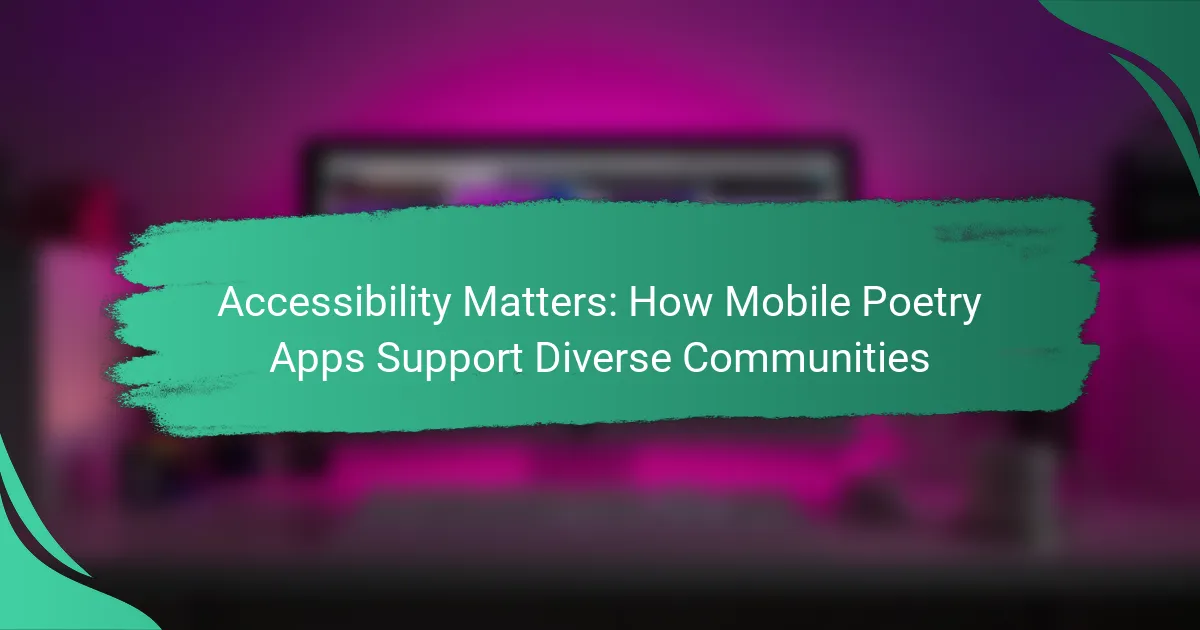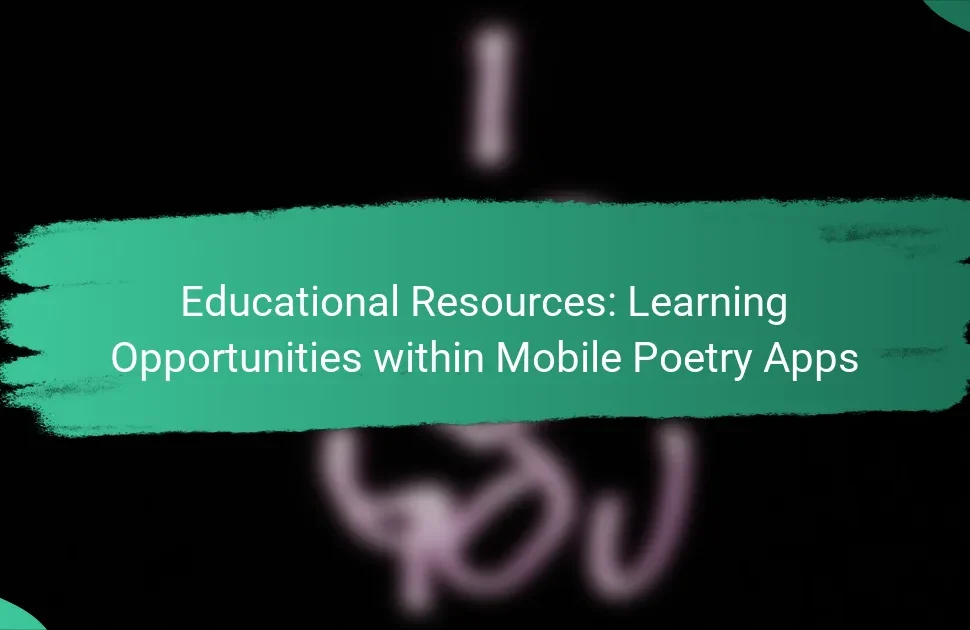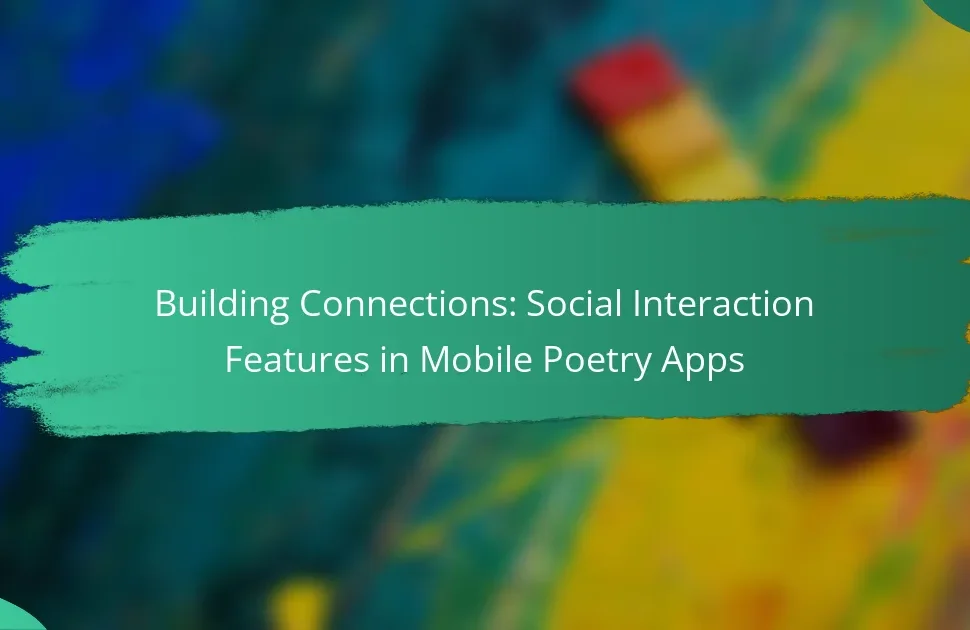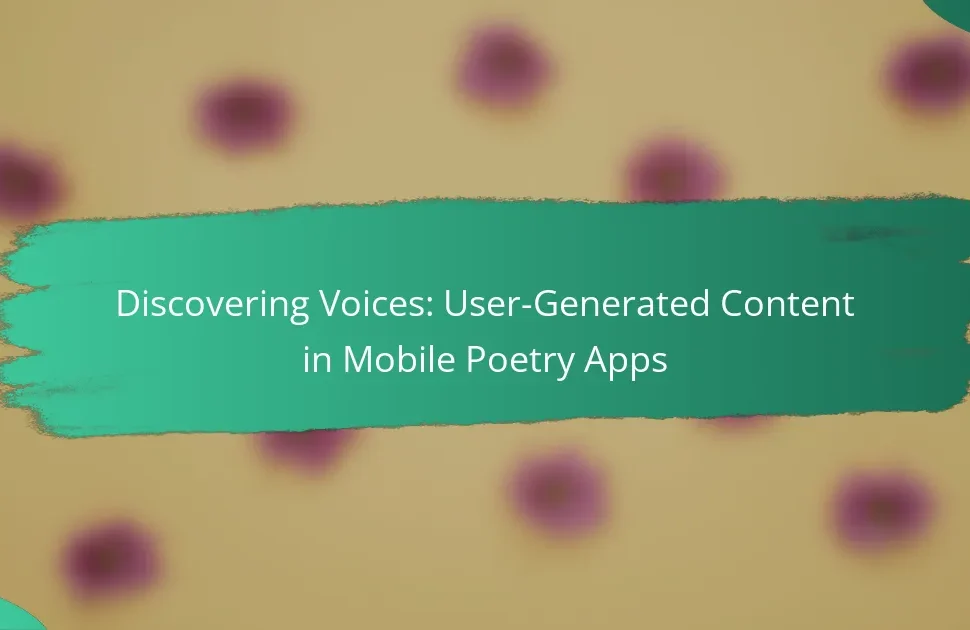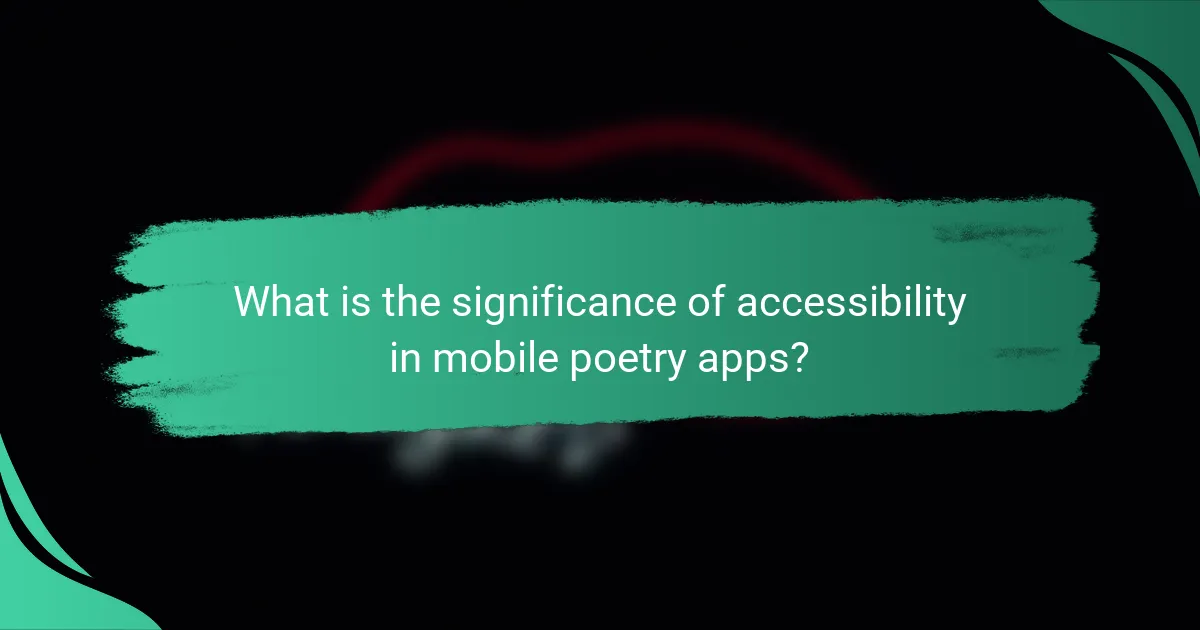
What is the significance of accessibility in mobile poetry apps?
Accessibility in mobile poetry apps is crucial for inclusivity. It allows individuals with disabilities to engage with poetry. Features like text-to-speech, adjustable font sizes, and high-contrast modes enhance usability. These elements ensure that users with visual impairments can access content effectively. Furthermore, accessibility promotes a diverse community of poets and readers. According to the World Health Organization, over 1 billion people live with some form of disability. This statistic highlights the need for accessible platforms. Therefore, mobile poetry apps that prioritize accessibility can reach a wider audience and foster inclusivity.
How do mobile poetry apps enhance accessibility for diverse communities?
Mobile poetry apps enhance accessibility for diverse communities by providing inclusive platforms for creative expression. These apps often feature user-friendly interfaces that accommodate various literacy levels. They support multiple languages, allowing non-native speakers to engage with poetry. Many apps include audio features, enabling visually impaired users to experience poetry through sound. Additionally, mobile poetry apps often provide community spaces for sharing and collaboration. This fosters a sense of belonging among users from different backgrounds. Research shows that technology can bridge gaps in access to literature and art. A study by the Pew Research Center found that 77% of adults in the U.S. own a smartphone, making mobile apps widely accessible.
What features make mobile poetry apps accessible to users with disabilities?
Mobile poetry apps can be made accessible to users with disabilities through several key features. These include screen reader compatibility, which allows visually impaired users to hear the text read aloud. High-contrast color schemes enhance readability for users with low vision. Customizable font sizes enable users to adjust text to their comfort level. Voice input functionality allows users to create and edit poetry hands-free. Additionally, closed captioning features support users who are deaf or hard of hearing by providing text for audio content. Lastly, simple navigation and intuitive interfaces ensure that users with cognitive disabilities can easily engage with the app. These features collectively promote inclusivity and accessibility in mobile poetry apps.
How do mobile poetry apps cater to different cultural backgrounds?
Mobile poetry apps cater to different cultural backgrounds by offering diverse content and features. They include multilingual support to accommodate various languages. This allows users to engage with poetry in their native tongue. Some apps feature culturally specific poetry to reflect local traditions and themes. Additionally, they provide customization options for users to express their cultural identity. Community features enable users to share and discuss poetry from their backgrounds. User-generated content often showcases a wide range of cultural perspectives. Overall, these apps enhance accessibility and inclusivity in the poetry community.
Why are mobile poetry apps important for community engagement?
Mobile poetry apps are important for community engagement because they provide accessible platforms for creative expression. These apps allow users to share their poetry easily, fostering connections within diverse communities. They often include features like collaborative writing and community feedback, encouraging interaction among users. Additionally, mobile poetry apps can reach underserved populations, breaking geographical barriers to participation. Studies show that digital platforms enhance cultural participation, making poetry more inclusive. By democratizing access to poetry, these apps strengthen community ties and promote cultural dialogue.
How do these apps foster connections among users?
Mobile poetry apps foster connections among users through interactive features and community engagement. These apps often include forums, comment sections, and sharing options that encourage user interaction. Users can share their poetry, receive feedback, and connect with others who share similar interests. Many apps also host virtual events or workshops, allowing users to collaborate and learn from each other. The accessibility of these platforms enables a diverse range of voices to be heard. According to a study by the National Endowment for the Arts, digital platforms enhance community engagement in the arts by 30%. This statistic reinforces the effectiveness of mobile poetry apps in building connections among users.
In what ways do mobile poetry apps promote inclusivity?
Mobile poetry apps promote inclusivity by providing accessible platforms for diverse voices. They allow users from various backgrounds to share their poetry easily. Features like text-to-speech and adjustable font sizes cater to individuals with visual impairments. Multilingual support enables non-native speakers to participate in poetry communities. Social sharing options foster connections among users from different cultures. Community-building features encourage collaboration and feedback among poets. Many apps host contests and events that highlight underrepresented voices. Data shows that inclusive platforms can enhance engagement and participation in creative expression.
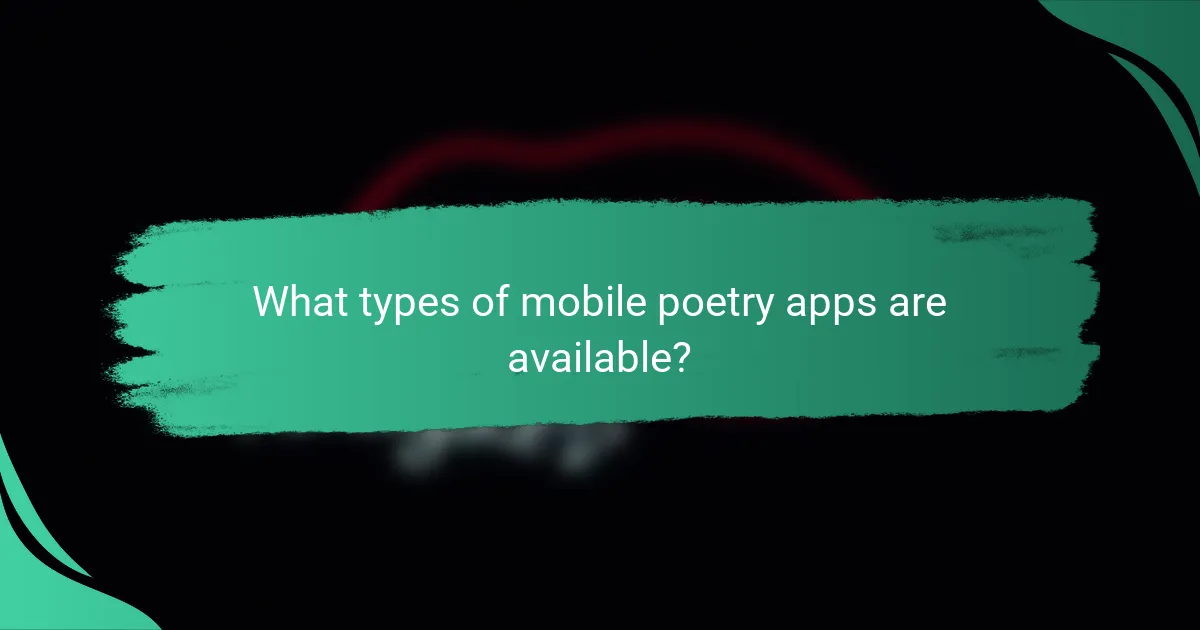
What types of mobile poetry apps are available?
Mobile poetry apps include writing, reading, and sharing platforms. Writing apps allow users to compose and edit poetry on their devices. Reading apps provide access to a library of poetry from various authors. Sharing apps enable users to publish their work and connect with other poets. Some apps focus on specific poetic forms, like haikus or sonnets. Others offer community features for feedback and collaboration. Popular examples include Poetizer, Verse, and Poet Assistant. These apps enhance accessibility for diverse communities by providing tools for expression and connection.
How do different mobile poetry apps address accessibility needs?
Different mobile poetry apps address accessibility needs through various features. These features include text-to-speech options for visually impaired users. Many apps offer adjustable font sizes and high-contrast themes to aid readability. Some apps provide audio recordings of poems, making them accessible to users with reading difficulties. Voice recognition capabilities allow users to compose poetry hands-free. Additionally, many apps include language translation features to support non-native speakers. Research indicates that these accessibility features enhance user engagement and inclusivity. For instance, a study by the National Endowment for the Arts highlights the importance of accessibility in expanding audience reach.
What are the unique features of popular mobile poetry apps?
Popular mobile poetry apps offer unique features that enhance user engagement and creativity. These apps often include customizable text formats for personalized expression. Many provide voice-to-text capabilities, allowing users to easily compose poems using speech. A collaborative feature enables users to share and co-create poetry with others in real-time. Some apps integrate multimedia elements, such as images and audio, to enrich the poetic experience. Additionally, interactive prompts and challenges stimulate creativity and encourage users to write regularly. Many apps also support various languages, making poetry accessible to a global audience. These features collectively foster a vibrant community of poets and enhance the overall user experience.
How can users choose the right app for their needs?
Users can choose the right app for their needs by evaluating specific criteria. First, they should identify their primary purpose for using the app. This could include reading, writing, or sharing poetry. Next, they should consider the app’s accessibility features. Features like text-to-speech, customizable fonts, and color contrast are essential for diverse users. Users should also check for user reviews and ratings. Feedback from other users can provide insights into the app’s functionality and ease of use. Additionally, they should explore the app’s compatibility with their device. Ensuring the app works on their operating system is crucial. Lastly, users should look for trial versions or free alternatives. Testing an app before committing can help ensure it meets their needs effectively.
What role do community feedback and collaboration play in mobile poetry apps?
Community feedback and collaboration are essential in mobile poetry apps. They enhance user engagement and foster a sense of belonging. Users can share their poems and receive constructive critiques. This interaction improves the quality of poetry within the app. Collaboration allows users to co-create works, leading to innovative poetic expressions. Research shows that user-generated content increases app retention rates. A study by the Pew Research Center found that 70% of users value community input in creative platforms. This feedback mechanism nurtures talent and encourages diverse voices in poetry.
How do users influence the development of accessibility features?
Users influence the development of accessibility features through feedback and participation in design processes. Their experiences highlight specific barriers they face while using technology. This input helps developers prioritize features that address real-world needs. For example, user testing sessions often reveal usability issues that developers may overlook. Surveys and focus groups gather insights directly from users about their accessibility requirements. Companies that actively engage users in these ways tend to create more effective solutions. Research shows that inclusive design leads to better user satisfaction and broader market reach. The involvement of users ensures that features are relevant and beneficial.
What are some examples of community-driven mobile poetry initiatives?
Examples of community-driven mobile poetry initiatives include the “Poetry in Motion” project and the “Street Poetry” app. “Poetry in Motion” allows local poets to share their work on public transportation, fostering community engagement. The “Street Poetry” app enables users to submit and share poems inspired by their surroundings. Both initiatives encourage participation from diverse community members. They enhance accessibility to poetry by using mobile technology. These projects have successfully brought poetry into everyday spaces, making it more relatable and inclusive.
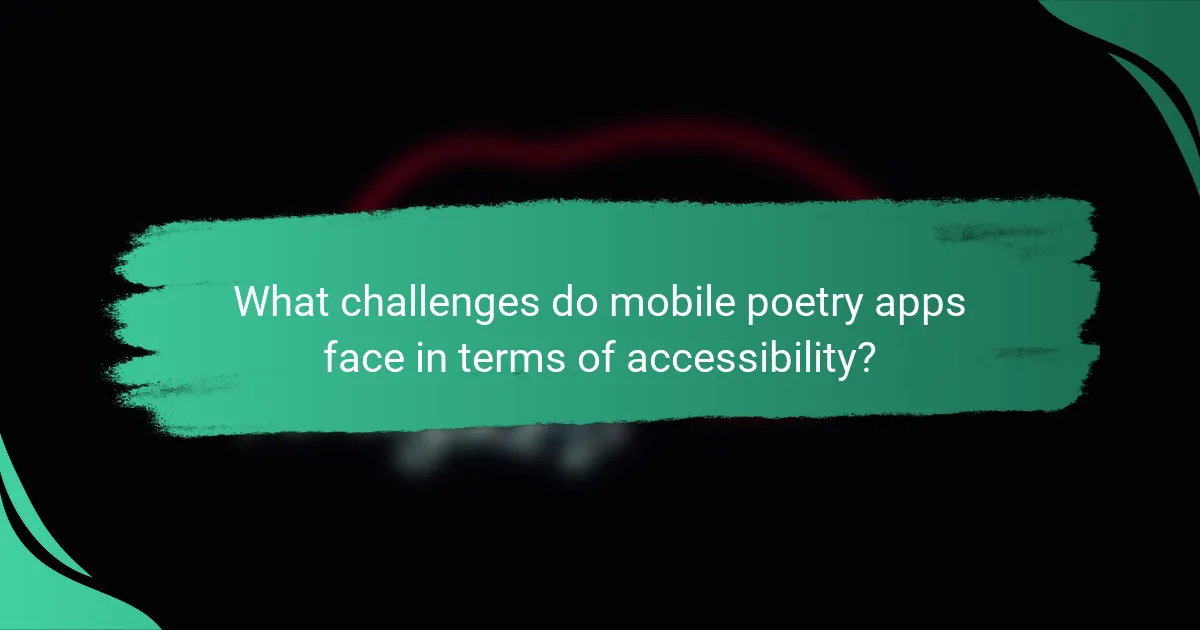
What challenges do mobile poetry apps face in terms of accessibility?
Mobile poetry apps face several challenges in terms of accessibility. One major challenge is the lack of compatibility with screen readers. Many users with visual impairments rely on these tools to access content. If the app does not support screen reader functionality, it limits their ability to engage with poetry.
Another challenge is inadequate text size and contrast options. Users with low vision may struggle to read content that is too small or lacks sufficient contrast. This can lead to frustration and disengagement from the app.
Additionally, mobile poetry apps often lack features for users with hearing impairments. For example, poetry readings or audio features may not have captions or transcripts. This excludes a segment of the audience from fully experiencing the content.
Furthermore, navigation can be complex in some apps. Users with cognitive disabilities may find it difficult to locate and read poems. Simplified interfaces and clear instructions can enhance accessibility.
Lastly, many apps do not consider diverse language needs. Users who speak different languages may find limited language options, which can hinder their experience. Addressing these challenges is essential for making mobile poetry apps more inclusive.
How can developers improve accessibility in mobile poetry apps?
Developers can improve accessibility in mobile poetry apps by implementing features that cater to diverse user needs. These features include screen reader compatibility for visually impaired users. Providing text-to-speech options enhances the experience for those with reading difficulties. Adjustable text size and contrast settings allow users to customize their reading environment. Incorporating alternative text for images ensures that visually impaired users understand visual content. Additionally, offering captions for audio and video poetry supports users with hearing impairments. Developers should also consider simple navigation and intuitive layouts to assist users with cognitive disabilities. Regular user testing with diverse groups can identify barriers and inform further improvements. These practices align with accessibility standards, promoting inclusivity in mobile poetry apps.
What are common pitfalls to avoid when creating accessible apps?
Common pitfalls to avoid when creating accessible apps include neglecting color contrast. Insufficient contrast can hinder visibility for users with visual impairments. Another pitfall is failing to provide alternative text for images. This omission prevents screen readers from conveying important information. Additionally, ignoring keyboard navigation limits access for users unable to use touchscreens. Not adhering to established accessibility guidelines, such as WCAG, can lead to widespread usability issues. Lastly, overlooking user feedback during testing can result in missed accessibility barriers. Engaging users with disabilities in the testing phase is crucial for identifying these issues.
How can user testing enhance accessibility features?
User testing can enhance accessibility features by identifying barriers that users with disabilities face. It provides direct feedback from individuals who rely on these features. This feedback helps developers understand specific needs and preferences. For example, usability tests can reveal difficulties in navigation for visually impaired users. By observing real interactions, developers can make informed adjustments. Research shows that inclusive design improves overall user experience. A study by the Nielsen Norman Group found that involving users with disabilities leads to better product outcomes. This approach ensures that accessibility features are effective and user-friendly.
What best practices should users follow to maximize their experience with mobile poetry apps?
Users should follow specific best practices to maximize their experience with mobile poetry apps. First, they should explore various features offered by the app. Features like text-to-speech and adjustable font sizes enhance accessibility. Users should also engage with community forums or discussion boards within the app. This interaction fosters a sense of belonging and shared learning. Regularly updating the app is crucial for accessing new features and improvements. Users should take advantage of curated poetry collections for inspiration. Finally, utilizing offline modes can ensure access to poetry anytime, regardless of internet availability. These practices collectively enhance user engagement and satisfaction with mobile poetry apps.
How can users customize settings for improved accessibility?
Users can customize settings for improved accessibility by adjusting features within the app. They can increase text size for better readability. Users may also change the color contrast to enhance visibility. Voice commands can be enabled for hands-free navigation. Screen readers can be utilized to read text aloud. Users can adjust playback speed for audio content. Customizable layouts can help organize content according to user preferences. These adjustments cater to diverse needs, ensuring a more inclusive experience.
What resources are available for users seeking support with mobile poetry apps?
Users seeking support with mobile poetry apps can access various resources. Many apps provide in-app help sections with FAQs and tutorials. Online forums and social media groups focus on users sharing experiences and advice. Websites dedicated to poetry often feature reviews and user guides for mobile apps. Additionally, some apps offer direct customer support via email or chat. User-generated content on platforms like YouTube can also provide visual tutorials. Community events and workshops may offer hands-on support for app users. These resources help users navigate and maximize their experience with mobile poetry apps.
The main entity of the article is mobile poetry apps, which play a significant role in promoting accessibility and inclusivity for diverse communities. The article highlights the importance of features such as text-to-speech, adjustable font sizes, and multilingual support, which enhance usability for individuals with disabilities. It also discusses how these apps foster community engagement through collaborative features and user-generated content, allowing poets from various backgrounds to connect and share their work. Additionally, the article addresses the challenges mobile poetry apps face regarding accessibility and offers best practices for developers and users to improve the overall experience.
